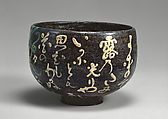Returned to lender The Met accepts temporary loans of art both for short-term exhibitions and for long-term display in its galleries.
Teabowl with Moonflower (Yūgao) and Poem
Ogata Kenzan Japanese
Not on view
Combining poetry, painting, calligraphy, and pottery, Ogata Kenzan achieved an innovative style with a potent visual effect. Against a black background that suggests a nocturnal scene, white flowers and deep green leaves glisten. As the name “moonflower” suggests, these blossoms open only briefly at night. The flower refers to the mysterious Lady Yūgao, featured in Chapter 4, “The Lady of the Evening Faces” (Yūgao), and symbolizes her fleeting life, cut short at the hands of Lady Rokujō’s jealous spirit. The waka inscribed on the teabowl reads:
Yorite dani
Tsuyu no hikari ya
Ika ni tomo
Omoi mo wakanu
Hana no yūgao
Upon approaching
In the glistening dew;
How unexpected,
The blossoming
Of the evening face.
—Translation by Richard Wilson
Due to rights restrictions, this image cannot be enlarged, viewed at full screen, or downloaded.
This artwork is meant to be viewed from right to left. Scroll left to view more.



